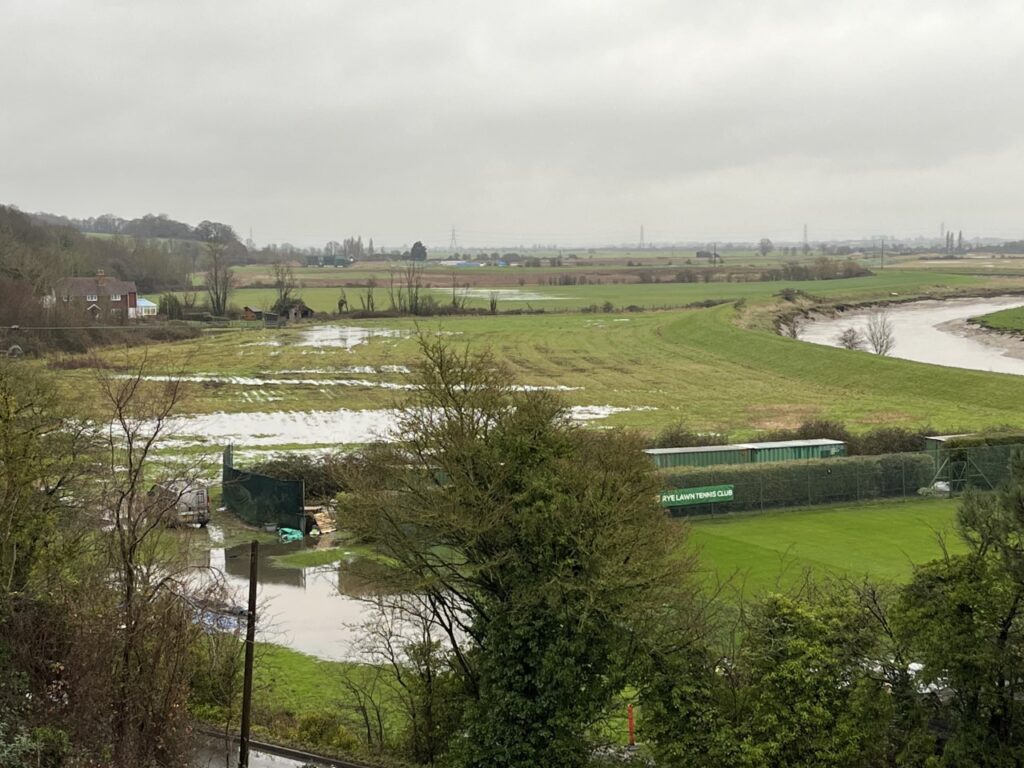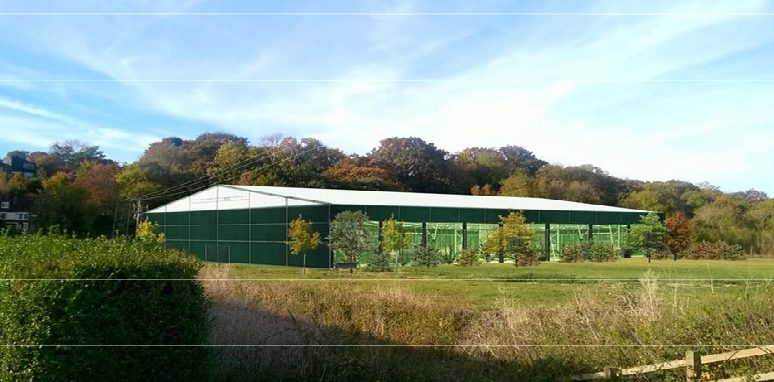Local residents have rekindled their opposition to Rye tennis club’s plan for a large structure housing three indoor tennis courts on Military Road.
Earlier this week, 14 objections, one general comment and two support comments could be seen on RDC’s planning portal after the project proposal was re-lodged.
Most of the opposition comes from Military Road residents, who point out the proposed site is subject to surface flooding, is located on a dangerous “blind bend” in the road and that the building itself will generate light pollution, noise and adversely affect local people’s amenity. The loss of a unique natural environment — home to diverse wildlife and plants — is also mentioned in objectors’ submissions.
Playden Parish Council has objected to the “large industrial appearance of the building”, which it says would be “prominent in views” from the East Guldeford Levels, the Rother river and its footpath, the A259, the rail line, Military Road and from neighbouring properties. PPC also indicates the tennis court site is next to the Dungeness, Romney Marsh and Rye Bay RAMSAR and SSI sites of environmental importance.

Rye Conservation Society referred to the original proposal as “an industrial-scale building in a rural landscape, far larger than any agricultural buildings in the vicinity”, which would produce “a serious and detrimental effect on the landscape”. It had also pointed out that the site lies outside the current Rye development boundary (where strict rules apply — namely that development should only occur where a countryside location is necessary).
Although there may be general support for an indoor sports facility of this nature in the Rye area — possibly in a location like Rye Harbour Road— most of the opposition focuses on claims the Military Road site is inappropriate for a structure of this size and type.
All weather indoor courts will allow club to thrive and grow
The tennis club describes the building as “a simple agricultural style steel framed barn structure clad in local timber cladding and louvres, with high level glass panels”. Plans indicate the structure will be about 54m long by 38m wide, reaching 9m at the roof apex. There would be car parking for 23 vehicles.
Rye Lawn Tennis & Squash Club originally applied for outline planning permission in 2016 but RDC’s planning team initially recommended refusal to the council’s Planning Committee due to the building’s “significant intrusive impact”, road/traffic issues, environmental considerations and surface water flood risk. However, by August 2019 outline permission was granted subject to various conditions and the subsequent approval of “reserved matters”.
The current application for outline planning permission was lodged last August, possibly because the earlier permission had expired.

At present, the club’s eight grass courts are only available between May and September, while there are also three all-weather courts. However, for various reasons the club is resisting the idea of converting its grass courts to all-weather use.
Rye tennis club believes the indoor court building, by offering year-round play, will attract greater participation in the sport, among adults and especially younger people. It will also enhance the long-term viability of the club. Although the club suggests the covered courts could be used by local schools, plus “community and non-member groups”, it seems too early to speculate what fee structure would be offered. At present, full adult club membership costs £463 a year (£378 tennis only) but under-18s only pay £76. Adult non-members can now play tennis for £10 each on up to four occasions a year, without joining the club.
The club admits in a submission that “to thrive and flourish, our club needs to change” and that without change it will undergo a “slow demise”.
A number of local people have suggested that if the covered court structure receives the green light, they would like to see access to the courts publicly available at a much lower price and without the need for costly membership.
Objectors cite problems with light pollution and flooding risks
Light pollution represents another important planning consideration. Sussex Police has told the planning authority that it believes a “constant level of illumination” would be needed to protect the covered tennis courts’ structure. It says shrubs around the proposed building should be less than 1m high and trees lower than 2m to allow for a “capable guardian” to observe the site. The county landscape architect insists a 5m-wide belt of mixed native tree and shrubs would be needed on the north and east sides, not the simple hedge suggested in the proponent’s design and access statement.
Opponents have claimed the illuminated building would be visible at night from a long distance. They also argue that a consultants’ flood risk assessment dates from 2015, while climate change risks have worsened since that date. The consultants admitted that surface water flooding was a threat but said river flooding would only occur if river defences failed and predicted a 1-in-200-year likelihood of this event.
Neither the Environment Agency nor National Highways offered objections to the proposal.
Further details of the planning application are available on the Rother District Council website under planning application RR/2022/1611/P.
Image Credits: Doug Parry , Rye Lawn Tennis Club .




Best wishes to Rye tennis clubs ambitious plans for the future of their club, once again the old chestnut rears its ugly head about a flood plain, but hang on a minute wasn’t the western barn development built on a flood plain,and also the one million pound houses at Rock Channel, interesting that playden parish Council are objecting,especially when one of their members lives near-by.
John, if you took the time to peruse the Rye Neighbourhood Plan, you’d see just how much of Rye is at risk of flooding. There’s a diagram to help you. Flood risk land represents a huge percentage of Rye. The town is on the confluence of three waterways. The new covered tennis courts WOULD be on the flood plain, right beside the river. It’s also adjacent to protected environmental sites. In my view, it was and is inadvisable to build next to rivers (as Martello did at Rock Channel) because of rising
sea level and more flooding. It was the main reason, coupled with the asking prices, that flats in this development proved difficult to sell. Playden PC is, I believe, the parish council for the tennis development and one would expect councillors to live in the parish. I assume any decision to submit a comment was made by a quorate council meeting, with a majority, and any councillor with an interest would have declared it. You could make the same argument about Rye TC, where councillors often vote on topics where they have an interest. For example, two RTC councillors were recently given substantial grants from the Rye Fund for their own projects. Go figure.
As a regular attendee of Rye Town Council meetings, may I take issue on Ian’s M’s last couple of sentences? One of the earliest items on every RTC agenda is “declaration of interests”, where Councillors declare any forthcoming items on which they have an interest. They may then be allowed to speak on those topics but abstain from voting.
I do not know which two projects Ian is referring to, but be assured that every grant agenda point which I have been present for has been thoroughly debated by the full council and decided by a vote (excluding those Councillors with an interest), based on the project’s merits.
Interesting neither the environment agency and highways have any objections, and of course anywhere will flood if we have enough rain, I wonder what the excuses will be once 21.8 million the estimated costs of the Eastern Rother wall is completed ,and in my view,Rye will be one of the safest places to live,once this wall is built.
This is in the planning application documents, from East Sussex County Council:
“The site is adjacent to the River Rother and is within Flood Zone 3 (High Risk) for rivers and seas. The site is also within a surface water flood zone (1% AEP / 100 year storm).
The Application is supported by a Flood Risk Assessment which does not meet the standard and content of information which we require to make a thorough assessment of the flood risks to the site and from the new development on the surrounding area in terms of potential alteration to the flood plain and increase in site runoff.
Consequently we object to this development on the ground of insufficient information at this time.”
No reason that the club can’t re-submit with sufficient information to satisfy ESCC, though.
The 4.5km Rother Tidal Walls East project from Scots Float sluice to Rye Harbour will raise the existing earth embankment by, I believe, 60-70cm. The upgrade forms part of the government’s Folkestone to Cliff End Strategy to protect Romney Marsh and Walland Marsh, which include 14,500 homes and 700 businesses. The project was approved by DEFRA in 2010 and presumably used sea level rise assumptions current at the time. Since then, ice melt and sea level rise have accelerated, leading to sea level rise now of 3.7mm a year. Even at this rate, the Rother embankment will be overwhelmed in a mere 19 years. It will be likely be sooner as ice melt is accelerating.The Larsen B ice shelf collapsed in 2002; scientists say the Thwaites Glacier (100 times larger) is in severe danger of collapse and would raise sea level by 50cm. Meltwater is pouring off the Greenland ice sheet and glaciers worldwide. A few days ago a report said sea ice around Antarctica had hit a record low, pointing to unprecedentedly high ocean temperatures. Nobody knows what the sea level will actually be in 2100, although NOAA estimates it could be anywhere between 30cm and 2 metres higher, or even 3.7m by 2150 if the ice sheets collapse. If global heating creates a tipping point, as many scientists believe, all bets on sea level are off.
The current RTWE scheme has a design life of 50 years, but I’d argue that from what we know about climate change and its impact on sea level, a 70cm increase in the Rother tidal walls is a stop-gap measure at best. My understanding is that the Environment Agency knows that additional embankment raising will be necessary, probably much sooner than expected. The point I’m making is that anyone who believes a vulnerable coastal community like Rye will be entirely safe from flooding in the next 50 years based on 70cm of additional tidal protection is sadly misguided. Significant new tidal defences will be required, and soon. Please note that the facts I use in this comment are taken from public government and local council sources and from the respected NOAA organisation.